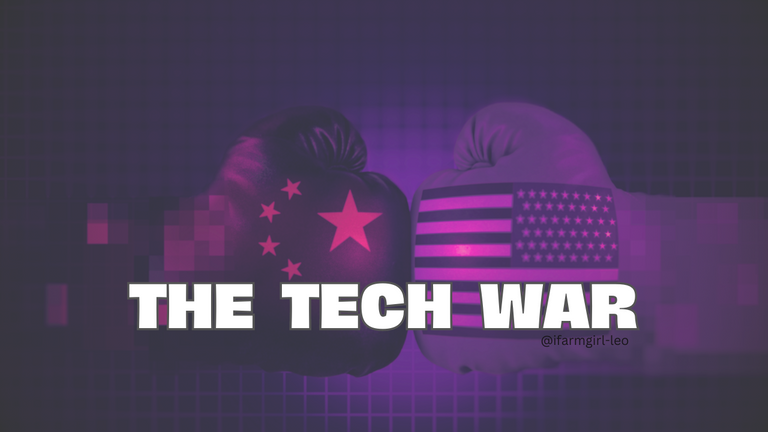The Tech War

Recently, China imposed sales restrictions on Micron, a US company which specializes on memory and storage products that are used in consumer electronics such as personal computers, communication and data centers, servers, healthcare and automotive industries. Micron is the world’s fourth-largest maker of semiconductors yet China reviews its product to be failing and I quote:
The review found that Micron’s products have relatively serious cybersecurity risks, which pose significant security risks to China’s critical information infrastructure supply chain and would affect national security. Source
This action by the Chinese government shows how the cold tech-war between the two countries have truly escalated. It is seen as China's retaliation to the restrictions and or sanctions by the US government in the previous years.
So what triggered the said tech war?
Apparently, the conflict started way back in 2015 "as a trade dispute, but soon morphed into a battle for leadership in core technologies like 5G, artificial intelligence (AI) and semiconductors." (Source)
The conflict is economically and politically motivated, because of two major aspects (economic and political), re:
"Made in China (MIC) 2025" - China desires to become self-reliant and put itself as the world's leader in high-tech industries and technology like AI, semiconductors and 5G
The US regards itself as being on the moral high ground in maintaining its global supremacy (includes economic and military implications) and sees China as a threat to its position so it intends to force China to abandon its policies in high-tech industries and technology transfer from foreign enterprises. (Source)
Trade sanctions
The US had been the leader in the global technology for decades and seen China as a threat to its position. It wants to stop the country from catching up. Hence, the US government from the Trump administration imposed trade sanctions, investment and export control, blocking or restricting the exchange of technological transfer for the purpose of widening and maximizing the technological gap between them two.
Sanctions Timelines:
January 2018: US lawmakers pressured American telecoms giant AT&T to pull out of a deal to distribute Huawei smartphones to US consumers. In July of the same year (7 months later) after the AT&T decision, Washington barred government agencies from purchasing equipment and services from the Chinese company. Examples of these are drones.
May 2019: Huawei was added to Washington’s Entity List, banning it from buying products and services from US companies without the US government approval.
May 2020: Washington expanded the reach of its sanctions by requiring foreign chip makers that use US technology to apply for a license to sell chips to Huawei. Ironically, China’s semiconductor sales grew more than 30% in 2020.
February 2021: The pandemic shown that the world generally relied on China for medical products such as masks and that prompted Biden to sign an executive order calling for a review of critical product supply chains for chips, batteries, pharmaceutical ingredients, and rare-earth minerals. All for the purpose of bringing back the supply chain to the US.
March 2021, the US Commerce Department further restricted what US companies can sell to Huawei, with more explicit prohibitions on the export of components like semiconductors, antennas and batteries that can be used in Huawei 5G devices. A day later, the US Federal Communications Commission designated five Chinese tech firms, including Huawei, ZTE, Hytera Communications, Hikvision and Dahua as an “unacceptable risk” to national security.
April 2021: US blacklisted seven Chinese entities involved in supercomputing, including Tianjin-based Phytium Technology, which had reportedly used American EDA tools, prohibiting them from receiving hi-tech exports from US companies or others using US technology to produce chips. (Source)
And while US had been blocking China's access to core US-controlled technologies like semiconductors, Beijing on the other has been doubling down on its efforts to become self-sufficient, spending billions in state funding towards its effort to materialize its own goal to become a world-leading manufacturing power, and away from being called "the world's factory".
August 2022: Biden signed the CHIPS and Science Act aimed at boosting the US semiconductor industry and reduce reliance on other countries and countering China’s growing economic influence, lowering the cost of goods, and mitigating supply chain disruptions. Accordingly, the said act will invest more than $200 billion over the next five years in a bid to help the US regain a leading position in semiconductor chip manufacturing.
The major focus of the bill is on making the US more competitive with China. The US was once the leader in semiconductor manufacturing but now many American manufacturers import chips made from other countries like China increased production. The share of semiconductor manufacturing capacity located in the US has decreased from 37% in 1990 to 12% in 2022. (Source)
According to a fact sheet, Micron announced a $40 billion investment in memory chip manufacturing, critical for computers and electronic devices, which will create up to 40k new jobs in construction and manufacturing. This investment alone will bring the U.S. market share of memory chip production from 2 percent to 10 percent. (Source)
Impact of the US-China tech war
Negative implications
The sanctions certainly affected China's economy which according to reports has seen its slowest GDP growth of the post-reform period, China’s factory output plunged to a 17-year low, its US-bound exports fell 6.5 percent, the Producer Price Index (PPI) turned negative and Nikkei’s Purchasing Manager’s Index (PMI) contracted for the third month in a row. Source
US and China have had economic losses with both sides imposing trade restrictions. And local companies and businesses relying on each countries' chips are affected.
The US government seem to have gone too paranoid that it stopped US companies and even government agencies from acquiring Chinese products like drones which led to catastrophic wildfires in 2020.
Positive impacts:
On the other hand, the war opened up a whole new opportunity for some countries, re:
Mexico and Canada have pushed China down the ranks to become the USA’s number one and two trading partners, while simultaneously raking in increased business from both the US and China.
With U.S manufacturing moving to other Asian nations that offer better labor costs, production costs and are US allies, these smaller countries (Vietnam, Thailand, Indonesia, Malaysia and India) are benefiting from it.
Brazil, Australia and Switzerland may also be benefitting from China’s retaliatory tariffs on cotton and soybeans. Additionally, China has expanded trade with African and Latin American countries who joined the BRI. (Source)
Personal Conclusion:
The tech war between the US and China has disrupted the semiconductor industry on a global scale and affected the supply chain, trade and technological development.
And whilst the US may have intended to curtail China's growth, the opposite may actually be happening. With the Chinese government supporting its local high-tech firms and focusing on building cutting-edge technology and innovation, they might as will be advancing in their own ground and may surprise the world one day soon.

Lead image created on Canva. No copyright infringement intended. 23rd May 2023/19:10ph
Info Sources:
Posted Using LeoFinance Alpha


Congratulations @ifarmgirl-leo! You have completed the following achievement on the Hive blockchain And have been rewarded with New badge(s)
Your next target is to reach 11500 replies.
You can view your badges on your board and compare yourself to others in the Ranking
If you no longer want to receive notifications, reply to this comment with the word
STOP